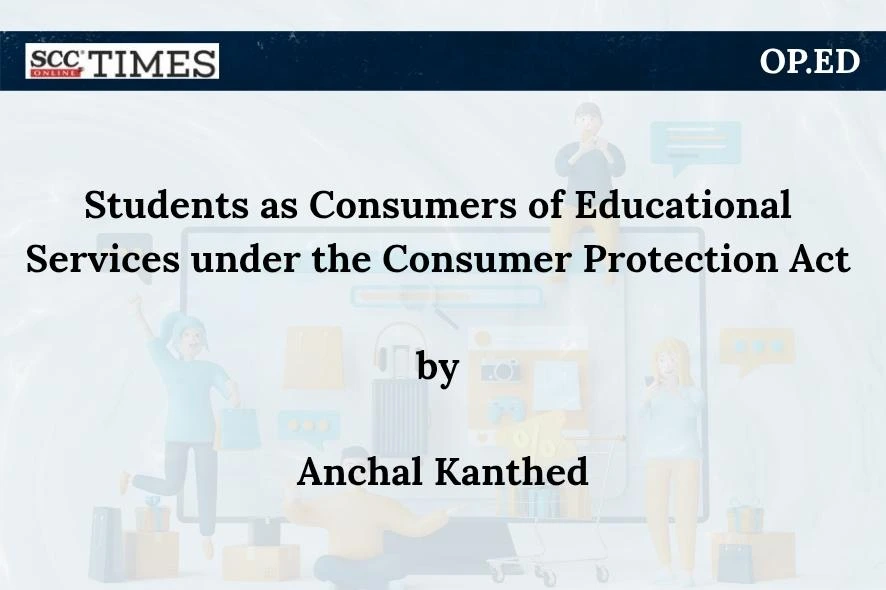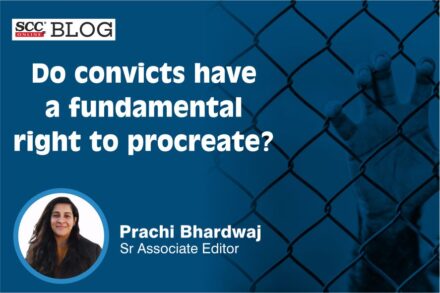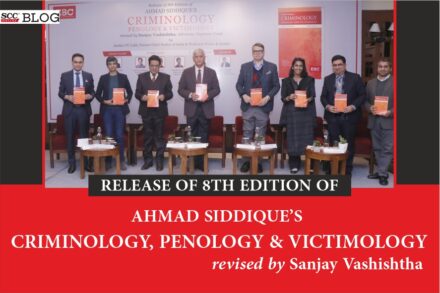Introduction
Education is core to the functioning of any country as the education sector is the largest in the world. In India, education forms an essential part of the economy. This sector has undergone a paradigm shift from the traditional concept of education to the modern and contemporary concept of education. Traditionally, it was for unskilled labourers who were not worried about their education, but now there has been a progressive shift of education being taken by the people for building employment and contributing to the service sector.1 Eventually, education became a fundamental right under Article
Now, from the cultural, religious and traditional notions attached to education, education is essentially becoming service-based which has to rise in growing controversies as to whether education is a service or not, whether students/parents are the consumers or not and whether the Consumer Protection Act, 19863 (CPA) governs the education sector or not. Since there are numerous conflicting judgments, ambiguity and confusion prevail as to the application of the CPA to the education sector. The purpose of this article is to explore the answers to these questions and analyse whether such controversies have been answered or not.
Understanding educational activities
Neither the RTE nor the CPA defines the term “educational activities”. National Consumer Disputes Redressal Commission (Ncdrc) defined it as:
First, those performed in the discharge of statutory duties, such as laying down rules and regulations for conducting examinations, eligibility criteria for permitting students to appear in the examination, the evaluation of the answer scripts and declaration of results, etc. and second, activities other than those performed in the discharge of statutory duties, such as the provision of admission, recovery of fees, etc.4
This definition classifies educational activities based on the power given to educational institutions under any statute. However, this definition cannot be taken as the model definition because administrative functions (like conducting examinations) are different from rule-making functions as given under any statute. Both of such functions require different powers, staff and capabilities and cannot be covered under the same classification. Moreover, there are some other activities as well which are incidental to the educational services but are not covered under this definition (eg., accommodation and mess). It does not consider the most important criteria of educational activities i.e. consideration. Therefore, this definition is not holistic. The author classifies educational activities as:
Firstly, primary educational activities involve direct interaction between teachers and students and the imparting of education. For example, classroom teaching, libraries, science laboratories, audio and visual activities, computer laboratories, etc.
Secondly, administrative activities like preparation of examination, declaration of result, conducting of examination, allotting roll numbers, seating arrangements to the students, providing of official transcripts and marksheets, providing of non-objection certificates, etc.
Thirdly, ancillary and incidental activities in primary education like hostels, cleaning of rooms in hostels, cleaning of bathrooms in hostels, cleaning of classes, cleaning of public toilets, laundry services in hostels, mess, canteens, maintenance of guest accommodation, healthcare clinic, mental health centres, sports ground, gym, etc. If any educational institute fulfils any of these criteria of educational activities, it will be termed to be providing educational services. Non-performance of any one of these activities will not be a factor to not constitute an educational activity.5 This definition of the educational institution is in line with the objects and purpose of the CPA as it brings under its purview as many services as possible.
What is a “service” under the CPA?
Section 2(1)(o) of the CPA defines the term “service” as:
2(1)(o). Service of any description, which is made available to potential users, including the provision of facilities in connection with banking, financing, insurance, transport, processing, supply of electrical or other energy, board or lodging or both, housing construction, entertainment, amusement or the purveying of news or other information, but does not include the rendering of any service free of charge or under a contract of personal service.6
This definition can be dissected into three parts as follows:7
First, the descriptive part, service includes “service of any description” available to “potential users”. On application of the literal rule of interpretation of statutes, “any” denotes every kind of service that can be contemplated under the CPA. It is inclusive of all the broadest interpretations and extraneous considerations.8 Such a definition even includes those definitions of the service which does not qualify as service in the literal sense. The use of the term “potential users” signifies the current users of the services and all those users who can be future users of the service as well. These users will include those users who are conferred upon some benefits from the performance of such service.9
Second, the inclusionary part, the word “includes” in any definition indicates that the list provided is not exhaustive and apart from what is mentioned in the list, there will be something else included in the enumerated part of the definition. The definition of service includes a total of 14 activities under services which is not an exhaustive list.10 This list so enumerated does not intend to limit the scope of the definition.11 For instance, services about the construction of houses, which are not included in the list, are included as a part of the service.12
Third, the exclusionary part, the exclusion is specifically about gratuitous (free of charge) and personal services. Since the definition is wide, the exclusionary element which excludes services that fall beyond the definition’s scope, forms a crucial function while the inclusionary part plays a less significant one as it can include other services as well. This exclusionary part is exhaustive in terms of its exclusions from the ambit of the term “services”.
Who is a “consumer” under the CPA?
Section 2(1)(d) of the CPA defines consumer as who:
(ii) hires or avails of any services for a consideration which has been paid or promised or partly paid and partly promised, or under any system of deferred payment and includes any beneficiary of such services other than the person who hires or avails of the services for consideration paid or promised, or partly paid and partly promised, or under any system of deferred payment, when such services are availed of with the approval of the first mentioned person.13 (emphasis added)
There has to be a consideration attached to the users/consumers who are using such goods and services. This consideration can be in any form or medium. The use of the goods directly by the user or by anyone on behalf of the user can be included under the definition of consumers. The definition of consumers is broad. It includes even a beneficiary of the services whose consideration is paid or partly paid and consumers who avail the services for hire. However, the definition explicitly excludes the persons who purchase goods for sale or resale under the ambit of the term consumers. Such exclusion is exhaustive.
Educational practices: Judicial analysis
(i) Primary educational activities
Primary educational activities includes direct imparting of education involving student-teacher relationship. The evaluation of such activities into any fixed matrix is very difficult. The stance of the judiciary is clear on the issue of primary educational activities that it is not a non-marketable and non-commercial activity which do not come under the ambit of the term “services”. Moreover, if the institute is statutorily established, the mandate of maintenance of the educational institution comes from the statute and thus, it is not a commercial activity. The judicial precedents are presented below.
|
Primary activity |
Case name |
Issues |
Decision |
|
Student-teacher relationship |
N. Taneja v. Calcutta District Forum14 |
(1) Are teachers education service providers? (2) Whether teacher’s refusal to promote the student a deficiency of service? |
(1) Given the traditional relationship between teachers and students, teachers are not service providers. Education is not a commercial good. (2) Education is not a trade-oriented activity to be included under service. |
|
Oza Nirav Kanubhai v. Centre Head Apple Industries Ltd.15 |
Is the student who is mistreated by a teacher and rusticated thereof entitled to a refund of fees? |
(1) There is a contractual relation between the educational institution and the student, as the institute is not statutorily established. (2) Educational activities are classified as services. |
|
|
Academy Educational Society v. Gorav Kumar16 |
What is the nature of activities included in the purview of the definition of educational institutions? |
(1) Teaching is not a marketable service and education is not an economic good. (2) Marketable activities of educational institutions are classified as services. Example: textbook, accommodation, etc. |
|
|
Regarding study material provided by the educational institutes |
Jai Kumar Mittal v. Brilliant Tutorials17 |
Does the study material that contains mistakes amount to a deficiency of service? |
There is a valid claim of deficiency of service as the institute provided erroneous materials to the students. Impliedly, students are consumers of the educational service. |
|
Deficiency in infrastructure |
Bhupesh Khurana v. Vishwa Budhha Parishad18 |
Whether the students are entitled to fee refunds from a fake university? |
(1) The institute must refund the fees. The Commission imposed punitive damages. (2) The institute indulged in deceitful tactics. (3) Educational institutions are providing educational services. |
(ii) Secondary/administrative activities
These activities include the activities which are incidental and closely connected with the primary education. The judiciary does not consider these services as educational services under the CPA. An analysis of the judicial decisions is presented below:
|
Activity |
Case name |
Issues |
Decision |
|
Examination fees |
University of Karnataka v. Poonam G. Bhandari19 |
(1) Whether administrative activities relating to examination a statutory function? (2) Whether examination-related activities classified as services? |
(1) These are not services for hire but statutory functions. (2) The candidate is not a consumer of these services. |
|
Board of Examinations v. Mohideen Abdul Kader20 |
(1) Whether negligence in the issuance of hall tickets with different subjects that are opted for is deficiency of service? |
(1) The Board conducts examination instead of discharging its functions under the statute. (2) The candidate has not been hired for such a service. |
|
|
Gujarat Secondary Education Board v. Bharat Narottam Thakkar21 |
Whether delay in re-evaluating the answers to the exam is a deficiency of service? |
No, a delay in re-evaluating the answers does not constitute a deficiency of service. |
|
|
Maharshi Dayanand University v. Ruchika Jain22 |
Whether students are consumers when they appear for examination? |
(1) Students participate in exams voluntarily to test their competency. Thus, students are not consumers. |
|
|
University of Bombay v. Mumbai Grahak Panchayat23 |
Whether delay in re-evaluating the answers to the exam is a deficiency of service? |
(1) Educational institutes are not providing services. (2) Students are not consumers of such administrative services. |
|
|
University of Jammu v. Brinder Nath24 |
Whether the negligence of the university and failure to act on the complaint of the petitioner for five years constitute a deficiency of service? |
No, there is no deficiency of service as there was voluntary participation of the student in the exam. |
|
|
H.P. University v. Sanjay Kumar25 |
Whether the failure to allot roll number and further not allowing the candidate to appear for the exam is a deficiency of service? |
Candidates are not consumers for statutory functions but the institutes can be held accountable for deficiency in allied administrative functions. |
|
|
Tuition/admission fees |
G.G.S. Indraprastha University v. Vaibhav26 |
Whether refusal to give back the fees when the student had unenrolled from the educational institution amount to a deficiency of service? |
The vacated seat does not bear any loss to the educational institution as it is filled up by another student. This amounts to a deficiency of service. |
|
Course Coordinator & Centre In-charge Indian Institute of Hotel Management v. Reshmi Dutta27 |
Whether retention of fees of the complainant by the institute when the complainant herself unenrolled herself on being dissatisfied with the course is deficiency of service? |
The vacancy of a seat after the candidate’s unenrollment is an irrelevant consideration as when she applied for the seat, she was not aware of the semester being started and she has missed a substantial number of classes. |
(iii) Tertiary educational activities
These activities are those services that are unrelated to primary education (direct imparting) but form a substantial part of educational service. In Swami Parmanand Para-Medical & GNM School of Nursing v. Pardeep Kaur28 it was held that if the complainant is dissatisfied with the poor service of accommodation which has led to him opting out of the education institution, then such accommodation facility will come under the ambit of educational service. In Madan Lal Arora v. Mahashya Chuni Lal Saraswati Bal Mandir Senior Secondary School29 the issue was regarding the drowning of a school child (aged: minor) constituted a breach of service and duty on behalf of school authorities. The Commission held in positive and constituted it as a part of service. However, in Fakhre Alam v. Amity Business School30 when there were similar facts and circumstances but the victim was a major, the Commission held the opposite by holding it not a service. There was no deficiency of service.
Contradictory opinions of the Supreme Court
|
Year |
Case name |
Decision |
Service |
|
2009 |
Bihar School Examination Board v. Suresh Prasad Sinha31 |
The Bihar Board is discharging statutory functions which are non-commercial. |
No |
|
2009 |
Frankfinn Institute of Air Hostess Training v. Ashwini G.32 |
Failure to provide required training which constituted an essential part of the programme constitutes a deficiency in service. |
Yes |
|
2012 |
P.T. Koshy v. Ellen Charitable Trust33 |
All educational institutions are outside the purview of the CPA and any consumer complaint cannot be instituted regarding deficiency in providing education. |
No |
|
2012 |
K. Rajendran v. CSI Ewart Matriculation Higher Secondary School34 |
Forcibly taking money and afterwards misappropriating funds by educational institutions constitute a deficiency in service by educational institutions. |
Yes |
|
2013 |
Indian Institute of Banking and Finance (IIBF) v. Mukul Srivastava35 |
If the educational institution is not a statutory body, the services rendered are under the purview of the CPA. |
Yes |
|
2014 |
Regional Institute of Coop. Management v. Naveen Kumar Chaudhary36 |
The false claim about the institute’s affiliation for offering a diploma program is not a deficiency in service. |
No |
|
2015 |
Dhirendra Kumar v. M.R. Sarangapani37 |
False representations about instate infrastructure, affiliation or recognition can be a deficiency of service. |
Yes |
Unresolved dilemma: Critical analysis
(A) Exemption to the statutory bodies: A correct matrix?
The object of the CPA is to include as many consumers and services as much as possible so that the consumers are not harassed and they have recourse to justice under various forums. Explicitly excluding statutory bodies from the ambit of services on the garb of their performing statutory functions is a flawed argument as the classification on the basis of their functions as private and public bodies is not based on intelligible differentia or reasonable nexus as the services given by such bodies are not different.38 The assumption of public authorities acting in good faith is questionable as to what is the basis of such classification. The feudalistic notion that the State cannot do any wrong is flawed. The sovereign is not always infallible, people have their fundamental rights against the sovereign as well which can be enforced when there is a deficiency of service by the sovereign. Moreover, such a notion is against the broader objects and purpose of the CPA. Also, the definition of the “service” does not exclude any such statutory functions as the exclusions given are exhaustive and the inclusions are broad. Any probable meaning of the services must be construed under the meaning of the term “service”.
Therefore, educational institutions conducting statutory functions not in a proper manner must come under the ambit of the services under the CPA to uphold the intention of the legislature by including the widest interpretation of the term services.
(B) Education is a commercial activity
The previous and traditional connotation attached to the educational services for religious purposes has now been changed. Now the times have changed, and educational institutions are charging higher fees (in lakhs or ten lakhs’ rupees a year) which clearly construe the trade-related motives of the educational institutions. Education is no longer construed as a service for social good. In the capitalist era, when no industry is susceptible to privatisation, education is no longer an exception. Even if the argument is accepted that education is accorded a pious character, that does not mean that education does not have any industrial character.
The data depicts that the private sector has significantly impacted higher education in India constituting 63% of private institutes and 52% of student enrolment in those private higher educational institutions.39 The education sector is not immune to the “evils” posed by commercialisation and applying modern and progressive concepts of privatisation to education will make education a commercial, marketable and industrial good done with profitable motives. Therefore, education is a commercial activity in a capitalist economy for all intents and purposes and the activities performed by such educational institutions must be included under the ambit of the term “service” as it is not a gratuitous service.
(C) Administrative fees must be included under the service
The fee receipts provided by the educational institutions include a bifurcation of the fees demanded by the educational institution. The receipt clearly indicates that some part of the fees is taken to conduct exams, declaration of results and production of marksheets, which means that the institutions charge the students for all the administrative services performed by the educational institutions. There is a consideration attached to providing services which means that it is a quid pro quo promise. Administrative activities confer benefits upon the students which is certification of their competency and knowledge. Such certification will be beneficial to the students in their future purposes. Credible certification is necessary for the course of activities by any student and therefore, even if no monetary worth is attached to such administrative services, still administrative services serve benefit to the students to certify their competence and knowledge. The definition includes service of any description that is inclusive of the administrative activities performed by the educational institutions and therefore, administrative activities must be included under the definition of service under the CPA.
Recommendations
(A) Amendment in the definition of “service”
There is a need for the legislature to resolve the numerous shortcomings and the oddities that have resulted from them. The simplest method to accomplish this is to amend the definition of service in Section 2(1)(o) of the CPA. This is how the term “service” should be defined:
Service means service of any description, which is made available to potential users, (which confers or causes to be conferred upon such users, a benefit) and (shall include) the provision of facilities in connection with banking, financing, insurance, (education) transport, processing, supply of electrical or other energy, board or lodging or both, housing construction, entertainment, amusement or the purveying of news or other information, but does not include the rendering of any service free of charge or under a contract of personal service.40
Since this definition includes the word “benefit”, this would be further defined as:
Benefit means any good, helpful or favourable circumstance, effect, condition or result, which accrues or is capable of accrual, in respect of the user of services, including, but not restricted to pecuniary, non-pecuniary, conditional, and intangible benefits, but excluding benefits of a purely spiritual kind, or of such kind, the evaluation of the manifestation of which, is or would be unduly hard or impossible.41
(B) Need for judicial interpretation of the term “educational activities”
The author understands the complexity involved in the legislative process of making amendments, but the author intends to highlight the importance of the judiciary in the interim to settle the dispute as to what will be included in the definition of educational activities. Any broader definition for a welfare statute is acceptable, but such a definition must take into consideration the three-tier educational activities presented in this article.
Conclusion
The controversies regarding the conflicting views of the judiciary about educational institutes being covered under the ambit of services or not have deprived people of getting the benefits of the CPA. This long-drawn controversy can be resolved if there is some clarity as to when and how educational institutions are included under the ambit of services and students under the ambit of the consumers. The author argues that there should be no exception to the definition of services apart from what is exhaustively mentioned in the definition of exclusion. The author concludes that the contours drawn by courts upon themselves regarding statutory functions, education being a religious activity and not a commercial activity, classification of educational services as administrative service and direct student-teacher relationship suffer from fallacies and any such limitations should not be made when the purpose of the legislation is protection of the rights of the consumers. The intent of the legislature can be upheld when no such exclusions are made and “all services of any description” are included under the ambit of services under the CPA.
*Final year student, Institute of Law Nirma University. Author can be reached at: anchalkanthed2205@gmail.com.
1. Higher Education in India: Moving Towards Global Relevance and Competitiveness (smartnet.niua.org, FICCI Higher Education Summit, 2014).
2. Right of Children to Free and Compulsory Education Act, 2009.
3. Consumer Protection Act, 1986.
4. Maharshi Dayanand University v. Ruchika Jain, 2006 SCC OnLine NCDRC 43.
5. Boards of Examination, like the Council for the Indian School Certificate Examinations (CISCE) and Central Board of Secondary Education (CBSE), are not involved in teaching or facilitating education but it will still be classified as an educational institution under those institutions performing educational activities.
6. Consumer Protection Act, 1986, S. 2(1)(o).
7. Indian Medical Assn. v. V.P. Shantha, (1995) 6 SCC 651.
8. CBSE v. Consumer Disputes Redressal Forum, 1993 SCC OnLine Ker 263.
9. LDA v. M.K. Gupta, (1994) 1 SCC 243..
10. LDA v. M.K. Gupta, (1994) 1 SCC 243.
11. Bharat Coop. Bank (Mumbai) Ltd. v. Employees Union, (2007) 4 SCC 685.
12. Bharat Coop. Bank (Mumbai) Ltd. v. Employees Union, (2007) 4 SCC 685.
13. Consumer Protection Act, 1986, S. 2(1)(d).
15. .
16. 2005 SCC OnLine NCDRC 23.
19. 1993 SCC OnLine NCDRC 122.
25. 2002 SCC OnLine NCDRC 122.
26. 2009 SCC OnLine NCDRC 119.
27. 2011 SCC OnLine NCDRC 190.
28. 2013 SCC OnLine NCDRC 363..
29. 2013 SCC OnLine NCDRC 363.
30. 2015 SCC OnLine NCDRC 1839.
34. 2012 SCC OnLine NCDRC 468.
36. 2014 SCC OnLine NCDRC 164.
37. 2015 SCC OnLine NCDRC 1410.
38. Suresh Prasad Sinha case, (2009) 8 SCC 483.
39. FICCI-EY Report, Higher Education in India: Vision 2040 (ficci-hes.com, February 2021).
40. Axay Satagopan, “Educational Activities as Service under the Consumer Protection Act, 1986”, NUJS Law Review 68-127.
41. Axay Satagopan, “Educational Activities as Service under the Consumer Protection Act, 1986”, NUJS Law Review 68-127.







Very comprehensive analysis👍
Member, Telangana District Consumer Commission, Hyd—